|
|
室利·阿罗频多最后的照片
已记不清何时才知道布列松是举世闻名的摄影家的,我对名头向来很迟钝,往往先知道作品而不知道作者或记不住作者。我只记得当我最早看到一幅咱们紫禁城里的太监的照片时,一个巨大帝国的如此缩影让我感到无比震撼。后来当我看到那个在大街上抱着两瓶酒得意而归的男孩的照片时,才知道作者叫布列松。
我买到一本中国摄影出版社引进出版的《珍藏布列松》,封面上写着:亨利·卡蒂埃-布列松作品全收录。但是在这里面我没有看到室利阿罗频多和“母亲”的照片。孤陋寡闻,他一生拍摄过哪些人的照片我并不知晓,但隐约中直觉告诉我:这不太可能!编者的眼界无此机缘,但他肯定有此机缘,如果上天赋予他总是在关键性时刻出现在关键之地去捕捉决定性瞬间的神奇机缘,那么设若他无缘于室利阿罗频多和“母亲”,此种神奇最终只能归至平淡无奇!
果不其然,上网一查,真正称得上神奇的机缘他确实没有错过,我书桌上摆放的室利阿罗频多端坐在单人沙发上的半身像就是他所拍摄!而那就是室利阿罗频多留给世人的最后照片。
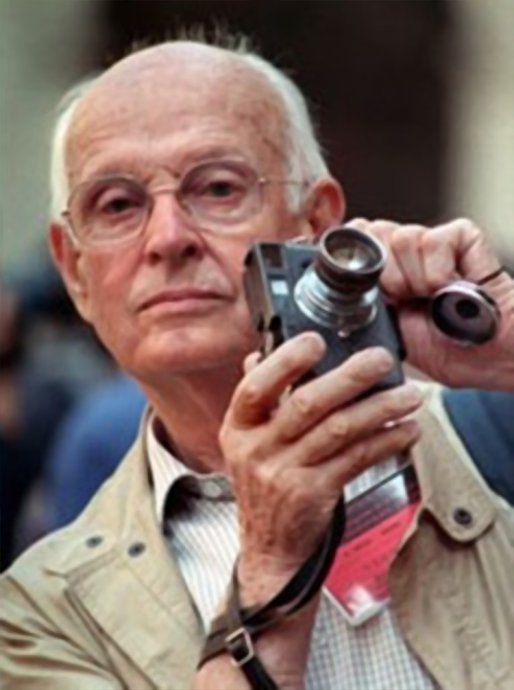
摄像师:布列松
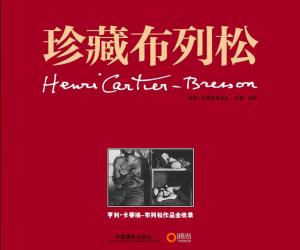
布列松摄像作品
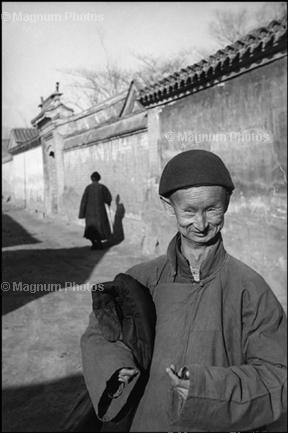
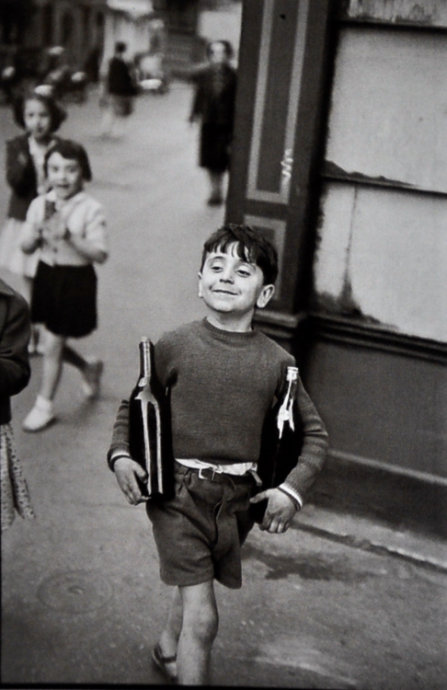
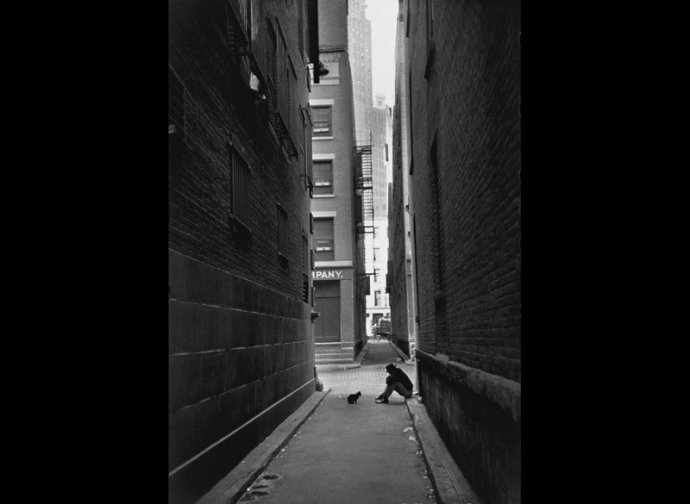
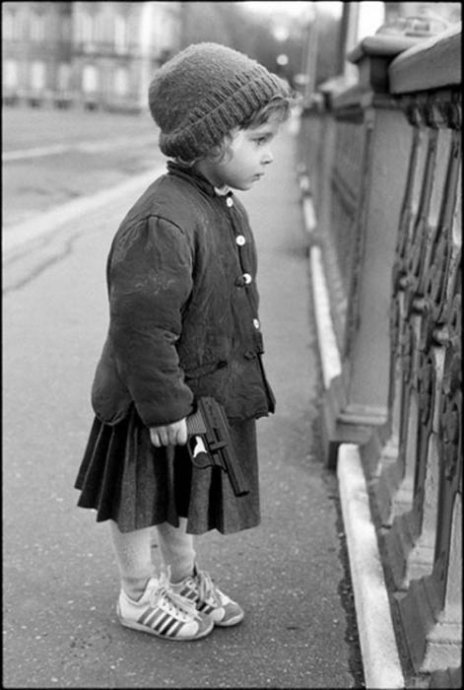
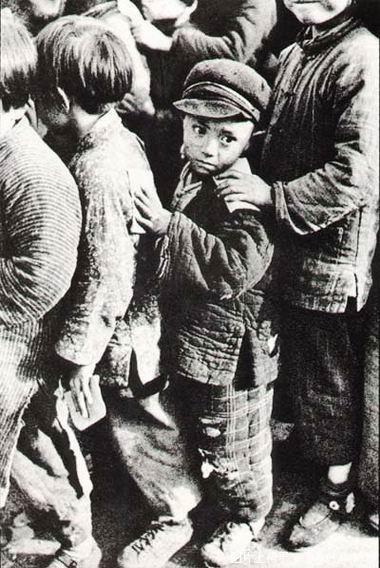
The Last Darshan Photographs of ri Aurobindo
Since the mid 1920s to 1950, no photographs of Sri Aurobindo were taken. In April 1950 the famous French photographer Henri Cartier-Bresson, came to Sri Aurobindo Ashram and asked the Mother to permit him to take Sri Aurobindo’s photographs. When the Mother gave him permission, Henri Cartier-Bresson took a number of photographs of the various activities of the Ashram and also some photographs of the Mother. On Monday, 24 April 1950 he took some photographs of Sri Aurobindo and the Mother giving Darshan.
自20年代到1950年这段时间,没有室利阿罗频的照片被拍摄过。在1950年4月,著名的法国摄影家亨利·卡蒂埃-布列松来到室利阿罗频多修道院,请求“母亲”允许他为室利阿罗频多拍照。时当“母亲”给了他许可,亨利·卡蒂埃-布列松拍摄了一些修道院里各项活动的照片,也拍了一些“母亲”的照片。在1950年4月24日,星期一,他拍摄了一些室利阿罗频多和“母亲” 给予“达瞻”的照片。
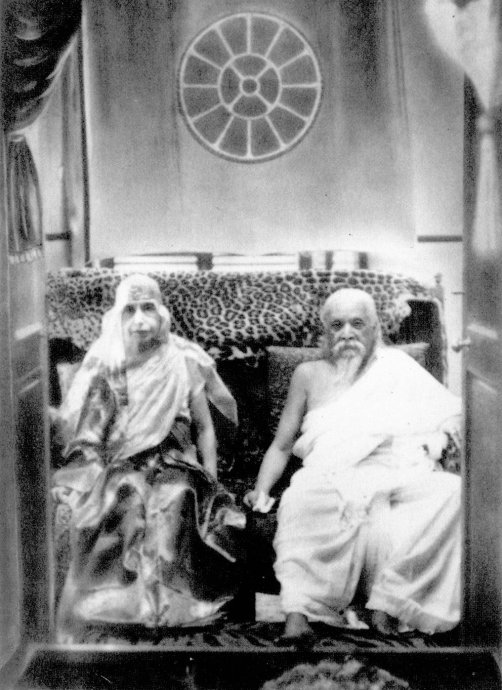
The Last Photographs of Sri Aurobindo
On 25 April 1950, the famous French photographer Henri Cartier-Bresson took a number of photographs of Sri Aurobindo in His room. Udar Pinto, who accompanied Henri Cartier-Bresson to Sri Aurobindo’s room recalls:
在1950年4月25日,著名的法国摄影家亨利·卡蒂埃-布列松拍摄了一组室利阿罗频多在“他的”房间里的照片。陪同亨利·卡蒂埃-布列松到室利阿罗频多房间的尤达·平托回忆:
‘…Mother called me and told me that She had permitted Henri Cartier-Bresson to take photographs of Sri Aurobindo. The Mother wanted me to help him with the handling of the equipment in the room and to assist him. She said, “Cartier-Bresson is going to take photographs. I am giving him permission. So you look after him. Do whatever he wants you to do.”… At that time we didn’t have such powerful lenses. And he said to Mother, “I regret that our present technology has not advanced so much to take a full beautiful picture in insufficient light. I’ll do the best I can.” And then he went to take pictures of Sri Aurobindo sitting in the chair. It was a wonderful and sweet experience, Sri Aurobindo sitting in the chair and I was by the side of the photographer. And he said, “Turn your head like this, look up, look that side, look this side…” Cartier-Bresson said he had never had a model like this who never moved or even blinked.’
“……‘母亲’唤我过去并告诉我‘她’已允许亨利·卡蒂埃-布列松为室利阿罗频多拍照。‘母亲’让我在房间里帮他处理摄影器材并协助他。她说,‘卡蒂埃-布列松打算拍照。我给了他许可。现在你去照看着他点。他要你帮他做什么你都去做。’……在那时我们还没有像现在这么功能强大的摄影透镜。因此他对‘母亲’说,‘很遗憾我们目前的技术还不能先进到在光线不足的情况下拍摄出一幅完美照片的程度。我将尽力做到最好。’然后他准备拍摄室利阿罗频多坐在单人沙发上的照片。这是一次美妙而甜蜜的经历,室利阿罗频多端坐在单人沙发上,而我就在摄影家的旁边。然后他说,‘像这样转动你的头,向上看,看那边,看这边……’卡蒂埃-布列松说之前他从未有过一个模特像这样一动不动甚至连眼睛都不眨。”
Henri Cartier-Bresson too has recalled the experience of taking Sri Aurobindo’s photographs in the following words: ‘Mother was so helpful and She convinced Sri Aurobindo and I came to his bedroom with my camera. The room was so neat and tidy and impersonal. Sri Aurobindo did not blink an eye during the entire ten minutes. I was watching him, he did not seem to belong to that impersonal setting.’ And in a tribute paid after Sri Aurobindo’s mahasamadhi, he remarked: “…when I had the privilege of seeing Sri Aurobindo, I had the impression that he was beyond time…”
亨利·卡蒂埃-布列松在下面的文字中也曾回忆过为室利阿罗频多拍摄照片的这一经历:“‘母亲’如此热心帮助,‘她’说服室利阿罗频多接受拍照,我带着我的照相机来到他的卧室。卧室是如此整齐洁净,不带个人色彩。在整个的十分钟的拍摄过程中,室利阿罗频多眼睛不眨一下。我观看着他,他似乎不属于那个不带个人色彩的端坐。’在室利阿罗频多示寂之后的一次致敬中,他评论道:“……当我获得优待见到室利阿罗频多的时候,我有此印象,他是超越时间的……”
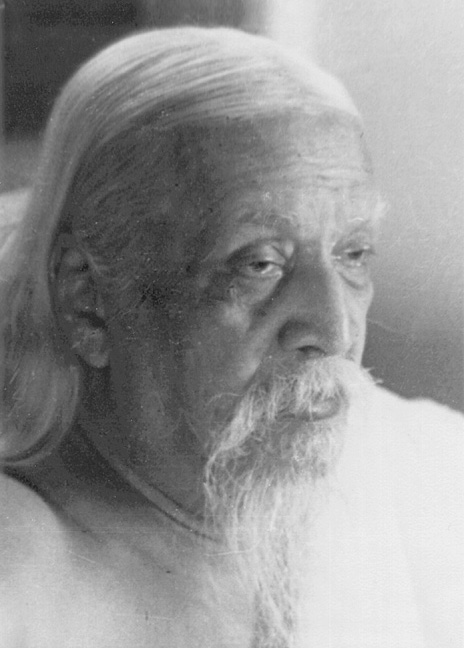
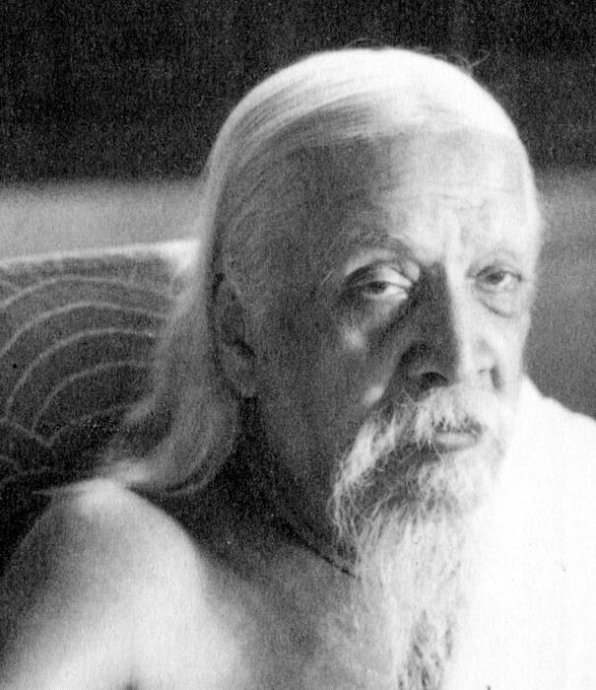
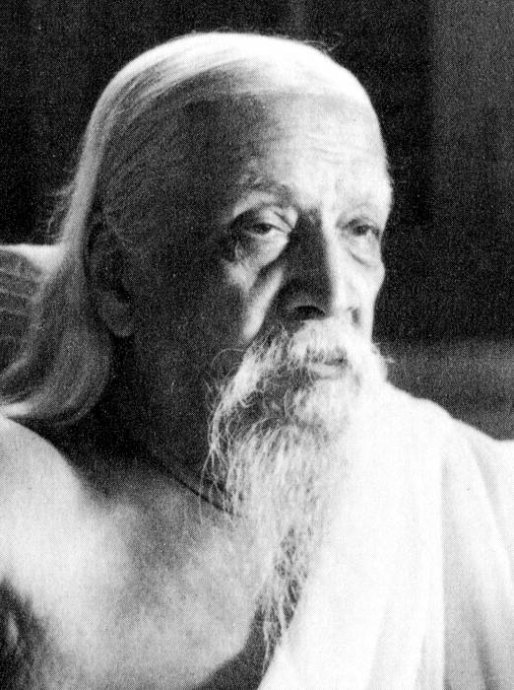
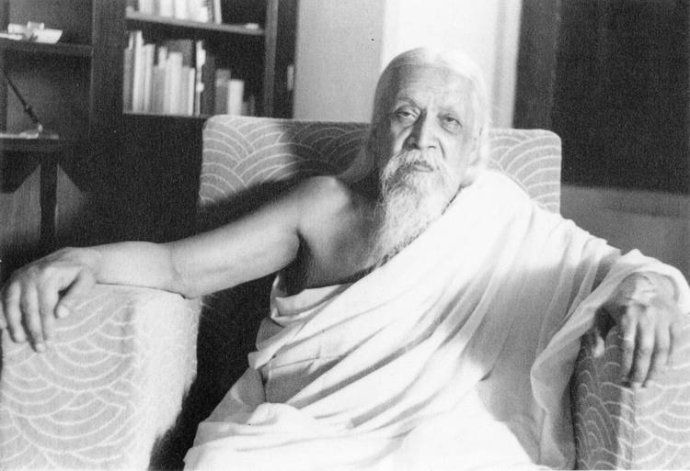
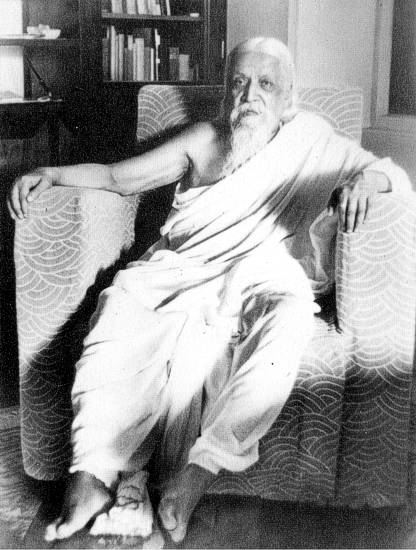
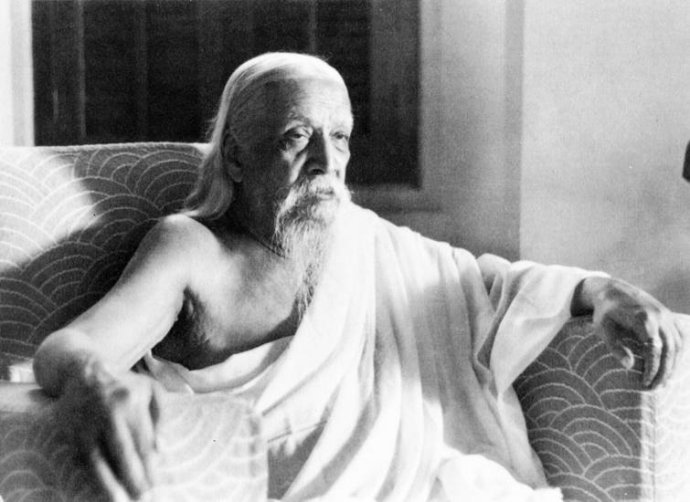
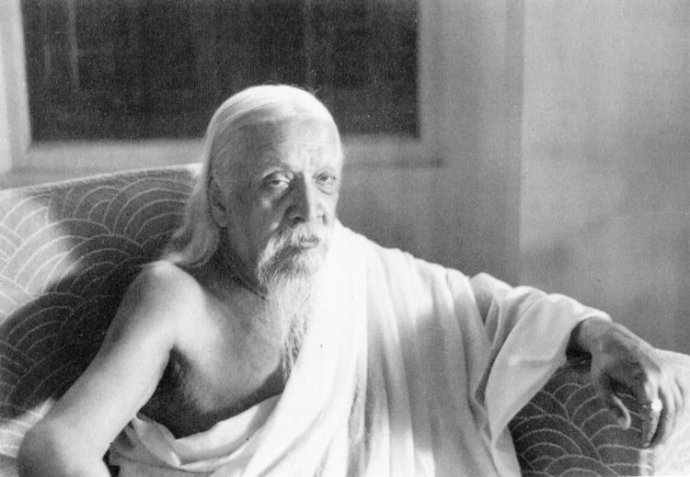
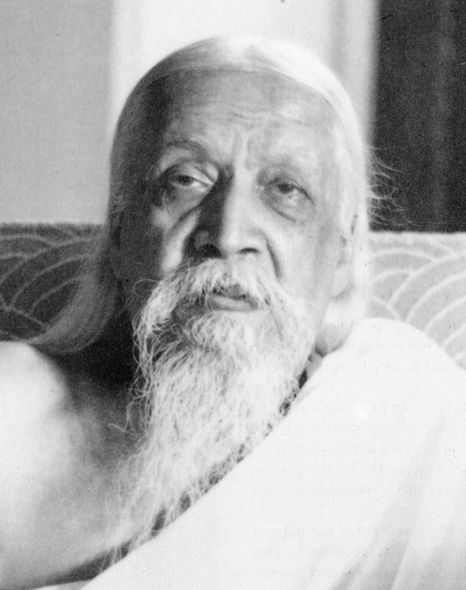
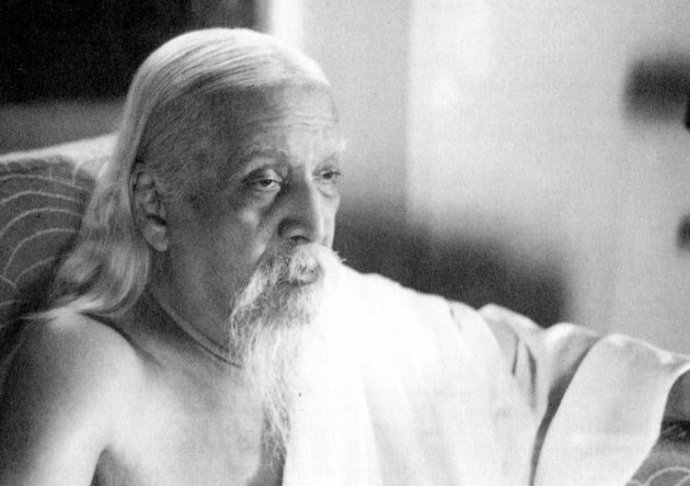
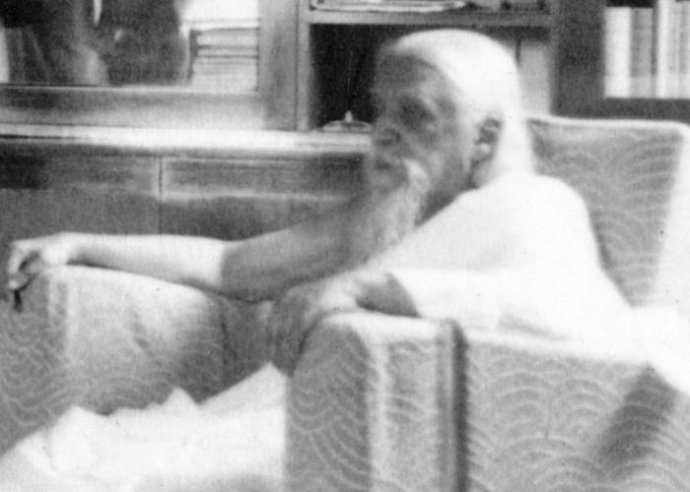
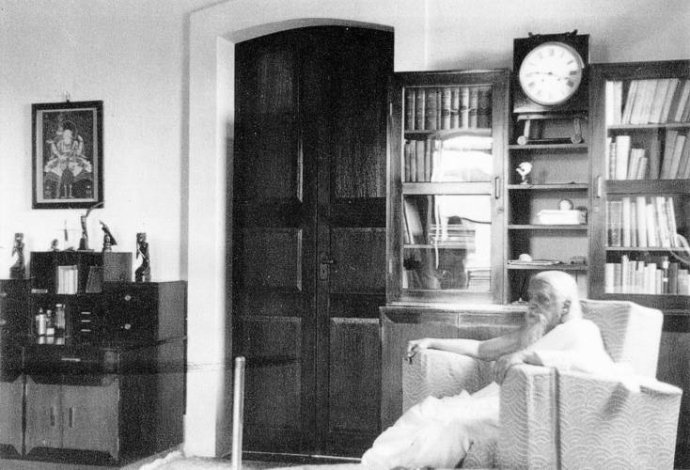
The Decisive Moment by Michael Miovic
决定性的瞬间
Henri Cartier-Bresson died on August 3, 2004, at his home in Paris, France. He was 95 years old. Widely respected as one of the founding fathers of photojournalism and a pioneer in the art of photography, his pictures are admired for their spontaneity and mastery of form. A painter both at the beginning and end of his career, Cartier-Bresson took up photography in 1930 and went on to shoot some of the most memorable photos of the 20th century.
亨利·卡蒂埃-布列松于2004年8月3日在法国巴黎的家中去世。享寿95岁。他作为新闻摄影的创始者之一,作为一位摄影艺术的先锋而广泛地受到人们的尊敬,他的照片因其自然和形式精当而备受赞赏。卡蒂埃-布列松在其事业生涯的最初和最终,同时亦是一位画家,其摄影创作始于1930年,其后不断地拍摄出一些二十世纪中最值得记忆的照片。
Cartier-Bresson always said his aim was to capture “the decisive moment,” that is, the essence of a situation or event that was unfolding before his eyes. Using a small hand-held Leica camera, and as little artificial light as possible, for four decades he roamed the globe catching human beings in the midst of action. From historic events, such as the funeral of Mahatma Gandhi and the rise of China’s Mao Zedong, to the smaller moments of workers relaxing or a family picnicking by the river Marne, he had a knack for being in the right place at the right time, and seizing the spirit of the moment.1
卡蒂埃-布列松总是说他的目标就是去捕捉“决定性的瞬间,”就是说,正在他的眼前展开的一情境或事件的本质。使用一架小小的便携式莱卡相机,尽可能少用人造光,四十多年来他漫步全球,捕捉人类在其间的活动。从历史性的著名事件,诸如圣雄甘地的葬礼、毛泽东中国的升起,到工人休憩或一个家庭在马恩河边野餐的微末时刻,他都拥有一种让存在恰逢其时恰处其位的诀窍,而抓住那一瞬当机的精髓。
There was certainly a yogic element to Cartier-Bresson’s art. He loved perfection, and his quest as a photographer was to glimpse eternity in the fleeting instant. Inspired by the philosophy of Zen Buddhism, he once said that his photographic method was to use his open eye to look through the viewfinder upon the outer scene, while with his other, closed eye he looked within.2 It was, perhaps, this inward gaze that caught the Mother’s attention and led her to grant him permission to photograph the Ashram in 1950.
就卡蒂埃-布列松的艺术而言必定含有瑜伽的要素。他热爱完美,作为一位摄影家他的追寻是在转瞬即逝中瞥见永恒。受佛教禅宗哲理的启发,他曾说他的摄影方法就是使用他张开的眼睛透过取景器观看外在的场景,而后闭上眼睛运用他的另一视见去看内中。或许,就是这种向内的凝视引起了“母亲”的注意,使得她在1950年给予他许可拍照修道院。
When Cartier-Bresson arrived in Pondicherry on April 23, in time for darshan on the 24th, he was in the midst of an extraordinary series of events. He had just come from Tiruvannamalai, where he had photographed Sri Ramana Maharshi leaving his body, and borne witness to the fireball that streaked slowly over Arunachala at 8.47 p.m., the exact minute of the sage’s absorption into the Self. On the 24th, Cartier-Bresson was to obtain the only photographs ever made of Mother and Sri Aurobindo together at Darshan, and on the 25th he was destined to shoot the last living photograph of Sri Aurobindo, thus completing a remarkable trinity of final statements—Mahatma Gandhi, Bhagavan Ramana Maharshi, and Sri Aurobindo.
当卡蒂埃-布列松在4月23日抵达琫地舍里时,正赶上在24日将要举行的“达瞻”,他身处于一系列非凡的活动之中。他刚刚自蒂鲁维纳马莱Tiruvannamalai【南印度一城镇名,以Arunachaleswara神庙最闻名】而来,在那儿他已为圣拉玛拉马哈希行将离开其躯体作了拍照,并且见证了晚上8点47分【拉玛拉于1950年4月14日晚8点47分示寂】火球从阿茹那查拉Arunachala【山名,拉玛拉在这座山的山洞里修行】的上空缓缓升起,这是这位圣者并入“大我”的精确时刻。在24日,卡蒂埃-布列松只获准拍照在“达瞻”时总是由“母亲”和室利阿罗频多构成的组合,而到了25日,他命定地要去拍摄室利阿罗频多生前的最后照片,如此使一个非凡的三圣一组的最后陈述成为完整——圣雄甘地、拉玛拉马哈希、以及室利阿罗频多。
By what Grace or hidden design the Divine chose Cartier-Bresson to record India’s three greatest leaders/spiritual figures of the 20th century as they stood on the threshold of life and death, we can only speculate. But clearly the phenomenon has a profound inner meaning. When Cartier-Bresson arrived in Pondicherry in April 1950, Sri Aurobindo had been in retirement for over 20 years, and had repeatedly declined requests to be photographed. In retrospect, we also know that Sri Aurobindo had already decided to leave the body, and was deeply engaged in two Herculean tasks: completing Savitri, and preparing for the first fully conscious descent into Death in the history of life.3 In a very real sense then, Sri Aurobindo was poised on the edge of his own decisive moment.
我们只能推测,当二十世纪印度三位最伟大的领袖/精神人物站在生与死的分界线上之时,“神圣者”选择卡蒂埃-布列松去记录他们的图像,是何等的恩惠或巧妙。然而无疑地这一奇迹具有一种深远的内中意义。当卡蒂埃-布列松于1950年4月抵达琫地舍里时,室利阿罗频多已经退隐20多个年头了,期间他一再拒绝被人拍照的请求。事后看来,我们也知道了室利阿罗频多已经决定离开他的身体了,他深深地埋头于两大艰巨无比的任务:完成《莎维德丽》,首次在其生命的历史上为充分明觉地降入“死亡”作准备。那么从一种非常真实的意义上来说,室利阿罗频多静定地处在他自己的决定性时刻的边缘。
Initially, the Mother only gave Cartier-Bresson permission to photograph the premises of the Ashram, as well as ashramites engaged in their usual activities. However, soon she allowed him to take shots with Mother in the background, and as the trust grew, Mother even let Cartier-Bresson take portraits of herself. Cartier-Bresson’s diary shows that he felt the Mother’s sweetness and kindness, and his photos of her distributing flowers certainly express this quality.4
最初,“母亲”只给予卡蒂埃-布列松拍摄阿施蓝处所的许可,如同驻足于阿施蓝中的人们从事于他们的寻常各项活动一样。然而,很快她就允许他随同“母亲”在后面选定镜头,随着信任的增长,“母亲”甚至让卡蒂埃-布列松拍摄自己的肖像。卡蒂埃-布列松的日记显示他感受到“母亲”的亲切和慈爱,自然,他所拍摄的“母亲”正在分配鲜花的照片表达出了这种特质。
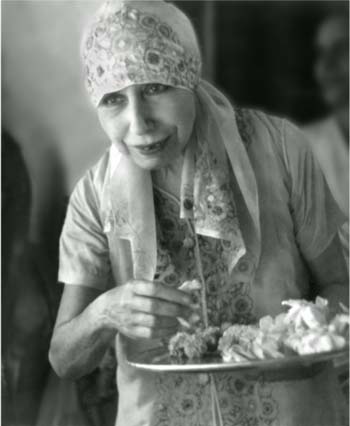
Yet the greatest photos were still to come. On the morning of April 25, 1950, the day after Darshan, Cartier-Bresson went to thank the Mother for the favours granted, and to ask for one more—permission to photograph Sri Aurobindo in his private quarters. According to Cartier-Bresson, he finally persuaded her with the statement, “I am only photographing the female aspect of the Divine. What about the male aspect?” In any case, the Mother consulted with Sri Aurobindo and—surprisingly—consent was given.5
最伟大的照片依然静待。1950年4月25日早晨,“达瞻”后的次日,卡蒂埃-布列松前去为“母亲”的青睐准许表示谢意,并进一步请求——准许他在室利阿罗频多的私人住处为其拍照。据卡蒂埃-布列松所说,他最终以其陈述说服“母亲”,“我只拍摄到‘神圣者’的偏于女性的那一方面。阳性的方面又怎样呢?”总之,“母亲”与室利阿罗频多商量——出人意料地——请求被答应了。
From the mechanical perspective, the session was quick and quiet. Cartier-Bresson took about 10 minutes, during which time Sri Aurobindo impressed the photographer with his complete immobility. In his diary from the time, Cartier-Bresson wrote “The room was so neat and tidy and impersonal. Sri Aurobindo did not wink an eye during the entire ten minutes I was watching him, he did not seem to belong to that impersonal setting.” During an interview in Paris, 40 years later to the day (25 April 1990), Cartier-Bresson recollected thus: “My impressions of the Mother—a power woman. Sri Aurobindo was very remote. I had ‘a tremendous meditation’ far away.”6
从机械的观点来说,拍摄的过程快速又安静。卡蒂埃-布列松拍摄了大约十分钟的时间,期间室利阿罗频多以其全然不动之态给摄影家留下了深刻印象。在当时的日记中卡蒂埃-布列松写着“房间如此整洁干净且不带个人色彩。室利阿罗频多在我观看着他的整整十分钟之内都未眨一下眼睛,他看起来并不属于那个不带个人色彩的端坐。”40年之后的这一天(1990年4月25日),在巴黎的一次接受采访中,卡蒂埃-布列松如此回忆:“我对‘母亲’的印象是——一位强大的女性。室利阿罗频多则是非常遥远。我有一种遥远的‘惊人的冥思’之印象。”
From the spiritual perspective, on the other hand, Cartier-Bresson’s portraits of Sri Aurobindo sitting in his armchair stand among the most substantial documents in human history. The side shots, in which Sri Aurobindo’s face is less prominent, are unproblematic, so we shall review these quickly. What one sees in these photos is a meditating sage who seems to have materialized on the film from the future. Sri Aurobindo barely appears to belong to this time and place: in the inner eye, one sees him as bolt of frozen lightning on the verge of striking, or perhaps striking so continuously that one can no longer distinguish rest and motion; outwardly, it seems as if the chair itself is about to launch forward and fly. Time has ceased, and the Timeless is radiating out of Sri Aurobindo’s figure with diamond intensity….
另一方面,从精神的观点来说,卡蒂埃-布列松所拍摄的室利阿罗频多端坐于他的单人沙发上的肖像位列人类历史上最重要的记录之中。显而易见,室利阿罗频多侧向的脸庞不显突出,因此我们会迅速地审视到这些。人在这些照片中所看到者是一个正在沉思的圣者,他似乎从未来的展映中已被具体化了。室利阿罗频多看上去几乎不再隶属这个时空:以内在的眼光,人看到他犹如一道耀眼的行将凝固了的闪电,亦或不断地闪耀着,以致于人无法分辨出其静止或移动;外观上,仿佛那扶手沙发本身亦将向前发射而飞翔。时间已停止,而这“永恒”正已钻石光芒的强度辐射出室利阿罗频多的影像……
However, the frontal compositions are more perplexing, especially the head-on portrait, so we shall dwell on it further. The first and most obvious feature of Sri Aurobindo’s last portrait is that he is not smiling. Also, he gives no revealing gesture or motion of note, and the composition seems rather static. There is nothing here to suggest transcendent bliss, not even that distantly tender smile from the Beyond that Welling captured in his famous bust of Sri Ramana Maharshi, shot only a few years earlier.7 On the surface, at least, Sri Aurobindo seems almost the antithesis of the jivanmukti that he was: his face is lined, his expression serious, and the atmosphere grave. This is not the delightful face of Krishna, rather the physiognomy of a warrior who has marched thousands of miles on foot and has yet, to borrow Frost’s famous line, miles to go before he sleeps. Even the Mother later commented that she was surprised by Sri Aurobindo’s look, for it was not the ever-patient and sweet visage she had come to know and love. “He… he let go…” she said poignantly.8
无论如何,这组照片中额面向前的部分更加复杂,尤其正面肖像,因此我们将会进一步地详述。首先室利阿罗频多这最后肖像的最显著的特征是他不是在微笑。并且,没有手势或动作意涵的展现,构图看起来毋宁是静态的。这里没有任何超验的福乐要去揭示,甚至没有那种来自“彼方”的若隐若现的温柔笑意,那种威林(G G Welling) 在他的著名的拉玛拉马哈希半身像中所捕捉到者,那照片就在几年前被拍摄。至少,在表面上,室利阿罗频多看起来几乎与他所是为即身了悟者的形象形成对照:他的脸部被拉长,他的表情是严肃的,气氛凝重。这不是克里希那的可爱面容,毋宁是一位在行进中已跋涉千万里并依然未竟的勇士面貌,借用弗罗斯特的著名的未竟之路的说法,在他睡去之前还要走上许多路程。甚至“母亲”后来评论说她对室利阿罗频多的面容感到诧异,因为这不是那个她所曾了解和热爱的永远耐心与亲切的面容。她令人心碎地说:“他……他要去了……”。
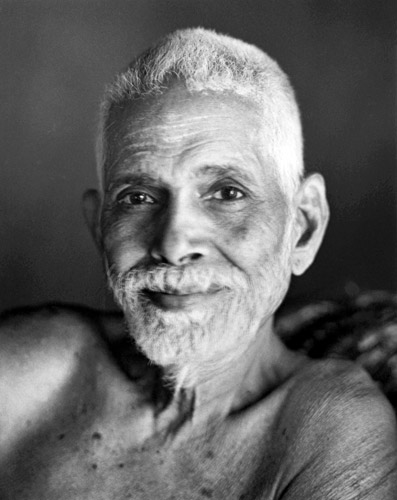
Close-up of Bhagavan Sri Ramana Maharshi , the famous 'Welling' bust
And yet, I feel, there is a deeper message and a divine purpose behind Sri Aurobindo’s solemnity, and artistically the inner dynamism of this photo is only accentuated by the composition’s seemingly static weight. For what we do see in Sri Aurobindo’s bare, frank look is the face of the supramental Avatar preparing to confront Death, to plunge into the very heart of Darkness and sow there the first seeds of the Life Divine. Sri Aurobindo looks grave here because the moment literally is grave. Make no mistake, this is no light lila of a God who does not feel the pain of human clay, it is the fully conscious surrender of the Godhead who has become the death-bound suffering that we are. Truly, this last photograph of Sri Aurobindo is the modern expression of Christ on the Cross, only the passion is inner not outer, and the Lord is dying in order to secure for us life everlasting on earth, not in some hereafter.
然而,我觉得,在室利阿罗频多严肃的背后有一更深的信息和一神圣的目的,在艺术上,这幅照片其内在的力度看来唯有以由构图的沉静来强调。因为我们在室利阿罗频多的袒露、直率中正所看到者,是此超心思的降世应身在准备面对“死亡”,去跃入完全的“黑暗”之心,首次在那里播种“神圣生命”的种子的面貌。室利阿罗频多在这里看上去的庄重是因为这一时刻确确实实是凝重的。不要误会,这不是一位无感于人类肉身痛苦的“神”的亮紫色,这是对神性的全般明觉的臣服,当此神性已变为我们被死亡限定的苦楚之时。真实地,室利阿罗频多这最后的照片是基督在十字架上的现代表达,只是受难曲是内在的而非外在,为了确保我们的生命在地球上而非在什么来世永续,上帝正在死亡。
Speaking for myself, I feel that Sri Aurobindo’s last portrait has a unique power of spiritual healing. It is not an easy photograph to live with, granted, and during my lighter moods and in the midst of my quotidian concerns I cannot bear to contemplate it deeply, for it is a profoundly serious testament. But when I am down, when I am feeling defeated, when I have reached the utmost limit of my endurance, then this photograph comes to me. Especially it speaks to me in my absolutely darkest passages, during those dire and decisive inner moments when it feels my very soul is on the verge of relinquishing the battle because the world’s burden is too great and my own failings unfixable.
对我而言,我感到室利阿罗频多最后的肖像具有一种精神疗愈的权能。即算如此,它并非那种可轻松相与的照片,在我心境轻浮的时候,在我日常的关切之中,我无法耐得住去深刻地凝视它,因为它是一种深切庄严的圣约。然而当我失意低落的时候,当我感觉被击败的时候,当我已濒于忍耐的极限之时,然后这照片来到我身边。尤其是对我来说在我绝对为最黑暗的阶段,在那期间,在那些可怕的和决定性的的内在时刻,时当它感到我们的灵魂濒临于放弃战斗,由于这世界的负担太大而我自己的失败无法弥补。
When I look to Sri Aurobindo’s last portrait in such times of critical need, then suddenly he looks different: I see that his face is my face, is every human face, is the Divine who has taken birth on earthly soil. I feel that his fatigue is my fatigue, is all human fatigue, is the Divine who has assumed the burden of human toil. I look into Sri Aurobindo’s left eye, and am taken in by the soft, receptive compassion of the divine Friend who understands my pains and errors because he shares them, whose sympathy is boundless because he walks right at my side and knows intimately every rock and pitfall on the Path. I look into his right eye, and am met by the steady gaze of Wisdom that looks dispassionately upon the labour of ages and fills me with a calm knowledge that the final fruits of evolution are as certain as the failures of the moment now seem. I look again upon the lined visage of the great Warrior who has fought so much, endured so much, and a new resolve enters my soul. I think “well, since He has borne so much for me, I must give something small in return. I will go one more step forward on the path—in honour of Him.” And so my heart warms again, and my will returns. I feel the arm of the great Protector around me, and the grim predator of darkness that was stalking my soul recedes, banished by a diamond Light that shines out from behind one human face.
时当我需要在这样的决定性时刻去看室利阿罗频多最后的肖像,然后突然间他看起来不同了:我看到他的脸就是我的脸,是每一张人类的面庞,是在凡世的土壤里已被降生的“神圣者”。我感到他的疲惫就是我的疲惫,是所有人类的疲惫,是“神圣者”已承担起人类的劳苦的责任。我凝入室利阿罗频多的左眼,被这种温柔的、善于接纳的这位神圣“朋友”的怜悯所收摄,他熟悉我的痛苦和差错,因为他共同承担它们,他的同情是无限的,因为他就在我的身边,密切地知晓在“道”上的每块绊脚石和陷阱。我深入他的右眼,遇见的是这沉着的“智慧”的凝视,越过千万年的劳作它冷静地注视着,以一种静定的知识充实着我,那是进化的最终结果,如同现在似乎是失败的时刻一样确定。我再次瞻望这位伟大“战士”的布满皱纹的面貌,他已战斗了那么多,忍耐了那么久,于是一个新的决心进入我的灵魂。我想“好吧,既然‘他’已为我负荷了那么多,我一定要给出点小小的什么作为报答。我将在道上向前更进一步——为了纪念‘他’。”于是我的心又温暖起来,我的意志重又回复。我感到这位伟大的“保护者”的手臂环绕着我,而残酷的潜伏进我灵魂中的黑暗掠夺者退回去了,它们被一种钻石般的“光芒”所驱赶,那光芒从一位人类的脸庞后面辉映而出。
This, for me, is the significance of Cartier-Bresson’s final portrait of Sri Aurobindo. It extends to struggling mortals the helping hand of an Avatar who otherwise might have remained forever impersonal and distant to us. For though Savitri and The Life Divine bring us glowing intimations from a brighter future, the weaker parts of us needed something else, too--this visual reminder that the supramental Avatar was also human like us. He is not only above and beyond us, He is also with and inside us, feeling our feelings, fighting our battles, facing the same mortality we face. Evidently, Sri Aurobindo knew exactly what he was getting in Cartier-Bresson, and he decided the French photographer was the right instrument to convey the Avatar’s parting gift to a suffering humanity—a gift made all the greater by its very humanity.
对于我来说,这就是卡蒂埃-布列松最后的室利阿罗频多肖像之意义。它与奋斗中的世人伸出一位降世应身的援助之手,否则对于我们来说他或许永远保持着他的非个人性和遥远。因为尽管《莎维德丽》和《神圣生命论》从一更加辉煌的将来给我们带来绚丽的宣告,然而我们的有体的较弱的部分还需要点其他的什么——肖像的视觉提醒我们这超心思的降世应身像我们一样也同属人类。他不只是超于我们而在我们之上,“他”也在我们内中和我们在一起,感受着我们的感受,奋斗着我们的斗争,面对着我们所面对的必死的命运。显然,室利阿罗频多确切地知道在卡蒂埃-布列松那里他所获得者,他确定让这位法国摄影师来作恰当工具以传达降世应身予以患难人类的临别礼物——一件由其全般人性的所有更伟大者所构成的礼物。
References参考文献
1.“Kingdoms of the world in a moment,” in The Economist, August 5, 2004.
2. Cartier-Bresson H. and Sand ML. The Mind’s Eye: Writings on Photography and Photographers. New York: Aperture, 1999.
3. Nirodbaran. Twelve Years with Sri Aurobindo. Sri Aurobindo AshramTrust: Pondicherry, 1972, pp. 265-292.
4. “Documents in the life of Sri Aurobindo: the last photographs of Sri Aurobindo,” in Sri Aurobindo: Archives and Research. Sri Aurobindo Ashram Press: Pondicherry, December 1990, pp. 207-09, 216.
5. Ibid.
6. Ibid.
7. Bhagavan Sri Ramana: a Pictorial Biography. Sri Ramanasramam: Tiruvannamalai, 1981, p. 102.
8. A conversation of 16 October, 1965.
“母亲”1965年10月16日的谈话中关于室利阿罗频多照片的内容:
(Soon afterwards, about a new disciple in France who asks for a photograph of Sri Aurobindo.)
(随后,谈到一位在法国的新门徒,他想要一张室利阿罗频多的照片。)
We are going to send him a good photo of Sri Aurobindo.
我们打算送他一张合适的室利阿罗频多的照片。
Which photo of Sri Aurobindo?
If he was brought up in a Christian way, it's the photo where he is young which is good, they instantly see in it the face of Christ!... All of them.... The day before yesterday again, an American painter, who is here and has read Sri Aurobindo's books, wanted to do a portrait of Sri Aurobindo (he never saw him) from photos – it's just as it was with the bust in Sri Aurobindo's room!1 They all make a mystic Sri Aurobindo with narrow temples, like that (gesture tapering upward), a long mystic face, because they can't get out of their Christianity! For them, of course, the Power, anything that expresses the Power, oh! ... (gesture of repulsion)
那么什么照片合适呢?
设若他是在一基督教的方式下被教育长大的,那么室利阿罗频多年轻时的照片对他很合适,他们立马就能在照片上看到基督的面庞!……他们所有人都能看到……这情形前天再一次地发生,一位美国画家,他在这儿并且已经阅读过室利阿罗频多的著作了,他想根据照片画一幅室利阿罗频多的肖像(他从未见过他)——这情形正如把半身雕像放置在室利阿罗频多的房间里一样!他们都籍着尖狭的庙宇作成一位神秘者的室利阿罗频多,像那样(示意向上越来越尖细),一张长长的神秘者的脸,因为他们不能出离他们的基督信仰!对于他们来说,自然,他们需要此“权能”,需要表达此“权能”的任何事,哦!……(表示反感)
I wanted to say that to this American.... For them, spiritual life is sacrifice, it's the God who sacrifices himself: he renounces the joys of the earth and sacrifices his existence to save mankind. And they can't get out of it!
我想说对于美国人……对他们而言,精神生活就是献祭,它是上帝牺牲他自己:他宣布放弃这尘世的欢乐而牺牲他的存在以拯救人类。所以他们不能出离于此!
So to those, it's the photo of the young Sri Aurobindo that should be sent, like the one in the reception room. Because he had just come out of his ascetic period here, and he still had a long face.
因此对于那些人,应该送给他们室利阿罗频多年轻时的照片,像在客厅里的那张。因为他刚刚结束他在这里的苦行时期,他仍然有着一张长脸。
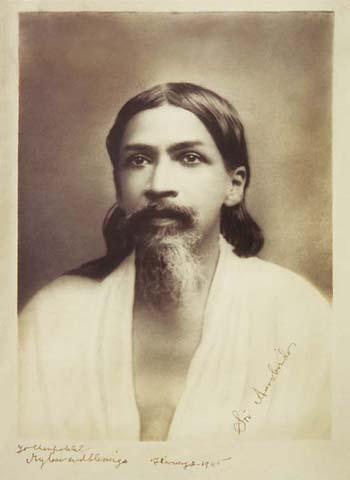
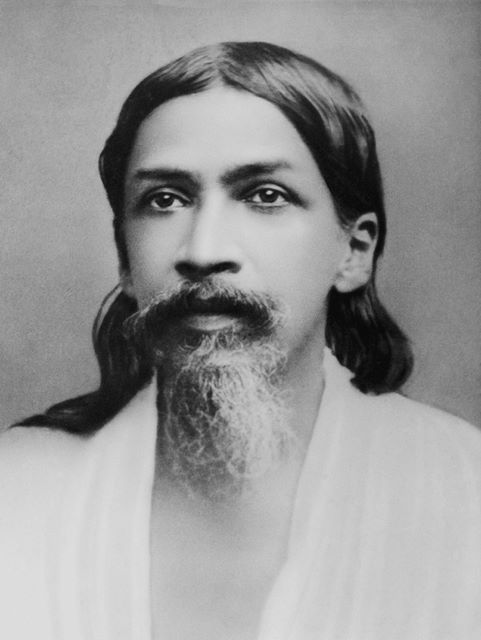
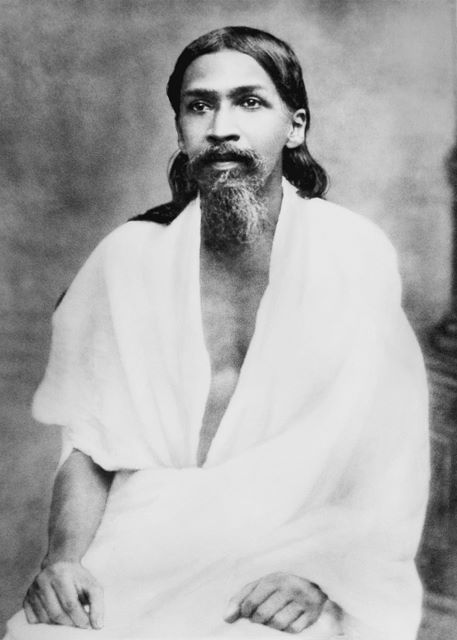
The photo in the armchair... it's a bit too late; he was already beginning to feel that... the world wasn't ready to go to the end. There is already the expression of suffering on his face.
至于在单人沙发上的照片……那就有点太迟了;他已经开始感觉到……这世界还未准备好前往它的目的地。在他的脸上已经有了苦楚的流露。
But the other photo is good. That's how I knew Sri Aurobindo: he had just come out of the photo in profile, in which he is very thin. As for Cartier-Bresson's photos, they were taken in 1950.
但是这组照片里面其他的还是不错的。那就是为何我知道室利阿罗频多:在侧面的照片中他刚刚从这种状态中出来,在这些侧面的照片中他就非常淡然了。关于卡蒂埃-布列松的这组照片,它们被拍摄于1950年。
It's a pity nothing was taken before.
遗憾的是之前他没被拍摄过什么照片。
Oh, he would never have let himself be photographed!
是啊,他从不愿让自己被拍照!
But when I saw the photo [of Cartier-Bresson, taken in 1950], when I saw he had that expression... Because, with me, he never had it; he never showed it. But I wasn't in the room when the photo was taken, and suddenly he... (he was sitting there, of course), he slackened. When I saw the photo (because they came long after, we had to write and ask them to send them), I was dumbfounded.... He had that expression.
但是当我看到照片时【卡蒂埃-布列松在1950年所拍摄的】,当我看到他已经有了那种流露……因为,和我在一起,他从未有过这种流露;他从未表现过。但是在照片被拍摄的时候我不在房间里,而突然间他就……(自然,他正坐在那儿),他放松了。当我看到这照片时(因为他们来过很久以后,我们不得不写信让他们把这些照片寄来),我惊呆了……看到他有了那种表露。
I always saw him with a perfectly peaceful and smiling face, and above all, the dominant expression was compassion. That was what predominated in his appearance. An expression of compassion so... so peaceful, so tranquil, oh, magnificent.
我总是看到他带着一种全般安宁和笑意的面容,尤其是,最突出的表现是慈悲。那是在他的外貌中为主导者。一种慈悲的现示……如此平和,如此平静,哦,皇华尊贵。
-------------------------------------------------------------------------------------------------------------------------------
1 That bust was made by a German woman (Else Fraenkel) and installed in Sri Aurobindo's room in 1958 at the disciples' instance. (One wonders why a bust, with golden illumination, was needed in this room.)
那座半身塑像是由一位德国妇女雕塑而成(Else Fraenkel),应门徒的请求在1958年被放置在室利阿罗频多的房间里。(人好奇为何一座半身雕像,金光闪闪,在这房间里为需要。)
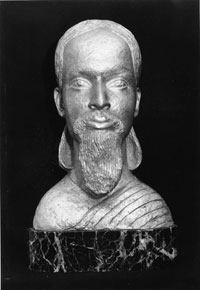
|
|